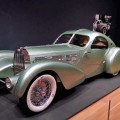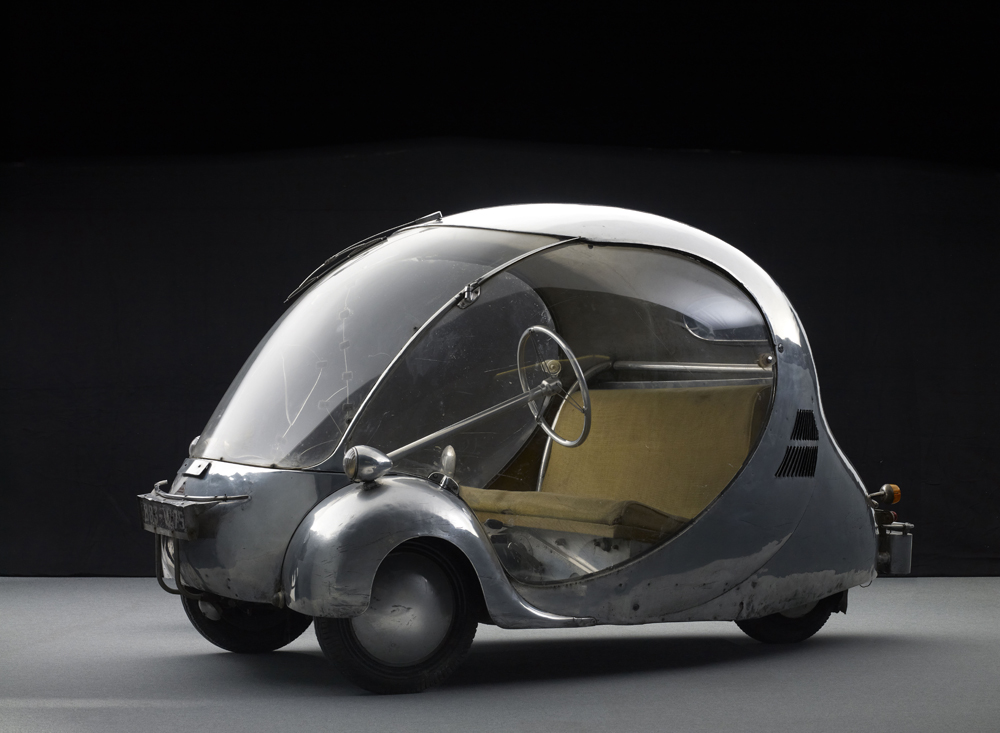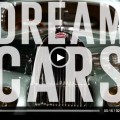Check out this great summary below of an event still on at the Indianapolis Museum of Art, featuring our very own Chrysler Ghia Streamline X “Gilda” on display with various other dream cars of the future. Details below:
What: “Dream Cars.”
When: May 3 through Aug. 23. Noon to 5 p.m. Sundays, 11 a.m. to 5 p.m. Tuesdays, Wednesdays, Friday and Saturday, 11 a.m. to 9 p.m. Thursday.
Where: Indianapolis Museum of Art, 4000 Michigan Road.
How much: Admission $18 adults, $10 ages 6-17, free for ages 5 and under and for members.
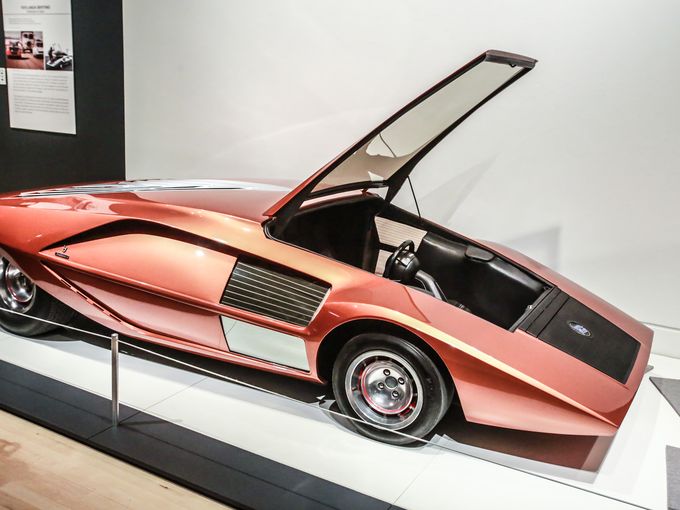
“Dream Cars” is an exhibit of 17 dazzling automobiles, but it’s not really an exhibit about cars. What the show — which opens Sunday — is about, really, is the imagination. It’s about impossible visions and personal fantasies. It’s about dreams that, by some miracle, tunneled their way into the real world.
What “Dream Cars” really is is a story of American exceptionalism and European sophistication. It’s a story of the intersection between art and engineering. It’s a story of how mere cars, progeny of the horse-drawn carriage and the bulky, utilitarian Ford Model T, became not only moving sculptures but also time machines, capable of preserving the ideals of their era while barreling forth into the future.
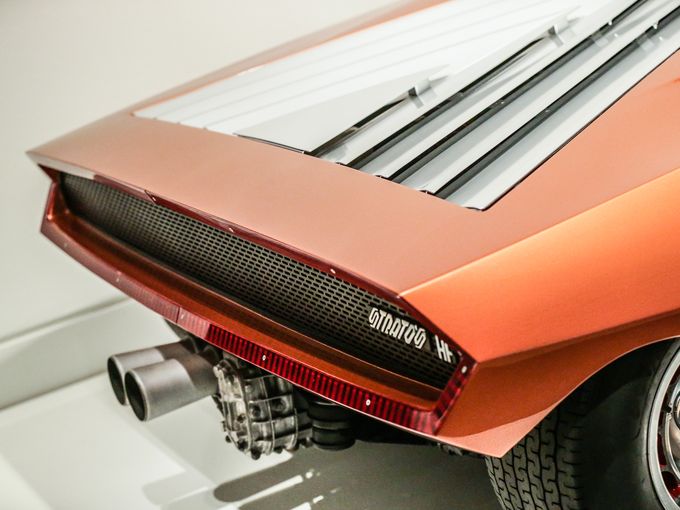
The story begins with the hunky roadsters by Ford and General Motors in the mid-1930s and ends with a 2010 Porsche concept and the platinum, lizardlike 2001 experiment by BMW’s Christopher Bangle, which featured a Spandex “skin” that allows the car to wink and open its hood from the center like a gaping mouth. “Dream Cars” captures both the prescient — an electric Smart car designed in 1942 — and the nostalgic — sports cars glittering with timeless machismo.
What more could be said of these metal beasts? The raisons d’etre of such gems as the 1941 Chrysler Thunderbolt — whose owner, Roger Willbanks, first encountered as a 5-year-old while perched atop his older brother’s shoulder at a dealership in Denver — is to be seen, not to be read or chatted about. There is no equivalent to witnessing the 1970 Lancia (Bertone) Stratos HF Zero as it opens itself up like an eagle stretching its wings.
This is far from the first time vehicles were treated as art. Cars have figured prominently in museums since the Museum of Modern Art exhibited “8 Automobiles” in 1951. “Dream Cars” drew praise and record visitors when it premiered at the High Museum of Art in Atlanta in 2014.
“When you go to a museum and look at a suit of armor, a vase or a piece of furniture, these are ostensibly practical objects that were beautifully designed and are on display for people to admire them,” says Ken Gross, celebrated car writer and “Dream Cars” guest curator. “So why not a car?”
Here, in chronological order, are the five cars you need to see (information courtesy of “Dream Cars: Innovative Design, Visionary Ideas” by Sarah Schleuning and Ken Gross”):
Edsel Ford Model 40 Special Speedster, 1934
Designed by Edsel Ford and Eugene T. “Bob” Gregorie.
75 bhp Model 40 flathead V-8 engine, alligator-style hood with louvered side panels, low-mounted faired-in headlights, cycle wings covering Kelsey-Hayes wire wheels.
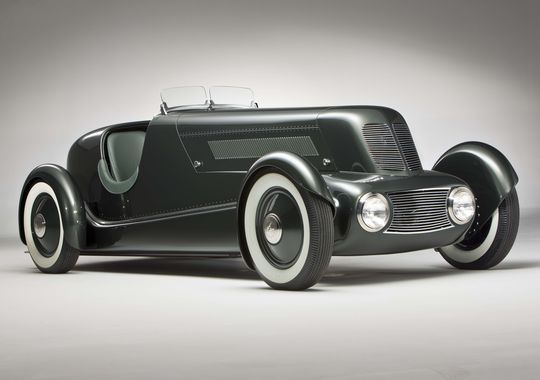
Edsel Ford Model 40 Special Speedster, 1934. Designed by Edsel Ford and Eugene T. “Bob” Gregorie. (Photo: Courtesy of the Edsel and Eleanor Ford House, Grosse Pointe Shores, Michigan.)
Big, bold and bulletlike, the Model 40 Special Speedster is a portal between the boxy styles of the past and the increasingly-aerodynamic shapes of the 1940s and on. With unprecedented long and low proportions, it inspired the 1935 Miller-Ford Indianapolis 500 two-man race cars.
Norman Timbs Special, 1947
Designed by Norman Timbs.
1947 Buick straight-8 engine fitted with factory-optional dual carburetors, fully skirted fadeaway fenders, close coupled cockpit without doors, raked and split windshield
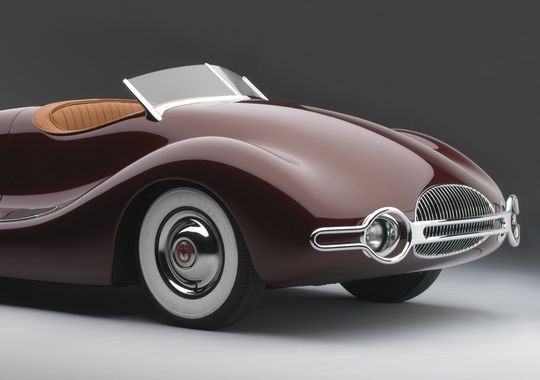
Norman Timbs Special, 1947. Designed by Norman Timbs. Courtesy of Gary and Diane Cerveny. (Photo: Provided by the Indianapolis Museum of Art)
This is the brainchild of the same man behind the Blue Crown Spark Plug Specials that won the Indianapolis 500 in 1947, 1948 and 1949. A sleek, radical maroon beauty with an aluminum tail that opens hydraulically from behind, like a clamshell.
General Motors Firebird I XP-21, 1953
Designed by Harley J. Earl, Robert F. “Bob” McLean, and General Motors styling section staff.
200 mph top speed, 2,500 pounds, turbine engine, experimental jet car design.
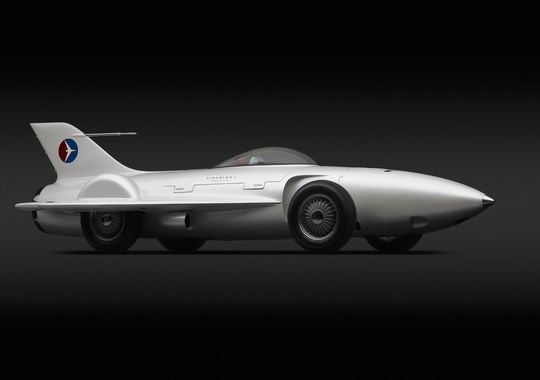
General Motors Firebird I XP-21, 1953. Designed by Harley J. Earl, Robert F. “Bob” McLean, and GM Styling Section staff. (Photo: Photo by Michael Furman.)
The Firebird has wings specially angled so that it won’t take off at higher speeds. The first gas turbine-powered American car ever built and tested, this wingless jet plane exemplifies its era’s ardor for concept cars and “flying” cars. Although it spawned the Firebird II and Firebird III, General Motors eventually abandoned the idea of a turbine-powered car due to technical impracticalities.
Chrysler (Ghia) Streamline X “Gilda,” 1955
Designed by Giovanni Savonuzzi and Virgil Exner.
“Shaped by the wind” wingless jet aircraft design. First conceived with 1,500-cc OSCA four-cylinder gasoline engine, 140 mph top speed. Later outfitted with gas turbine power plant, producing a characteristic shrill jet engine whine.
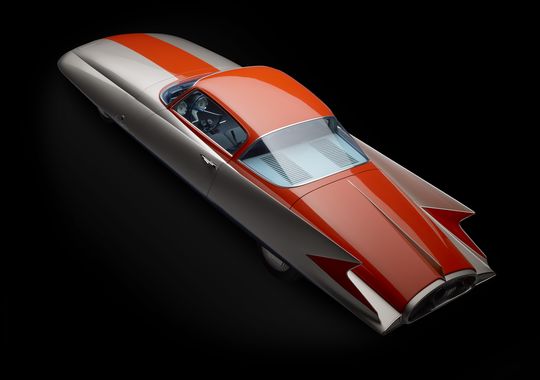
Chrysler (Ghia) Streamline X “Gilda,” 1955. Designed by Giovanni Savonuzzi and Virgil Exner. Courtesy of Scott Grundfor and Kathleen Redmond. (Photo: Michael Furman)
The zeal of the Postwar era for automotive design ushered in sleek, metallic concepts inspired by jet aircraft. The “Gilda” — named after 1946 film noir starring Rita Hayworth, who was described by Savonuzzi’s daughter, Alberta, as a “super-sexy bomb” — is a rocket on the road with a low-hanging style that influenced Chrysler’s 1957 “Forward Look” line.
BMW GINA Light Visionary Model, 2001
Designed by Christopher Bangle.
Water resistant, translucent textile body with seamless polyurethane-coated Spandex fabric exterior, deployable rear spoiler, moveable rocker panels.
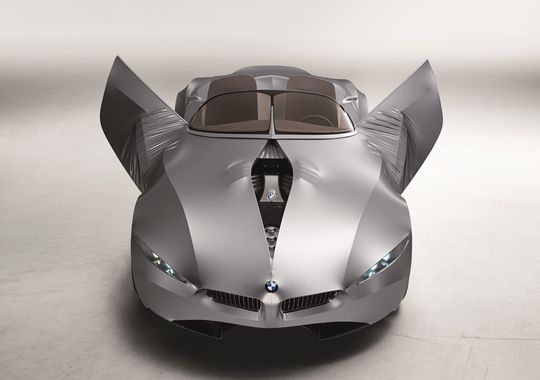
With a skin that molds to its changing shape, BMW’s GINA challenged the notion that cars have to be made of metal. (Photo: Photo provided by BMW)
With a skin that molds to its changing shape, the GINA challenged the notion that cars have to be made of metal. Designed to push BMW’s design forward and explore a potentially superior production process, the car was ultimately deemed unpractical for safety reasons, though its design inspired BMW’s future roadsters.
